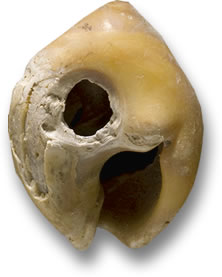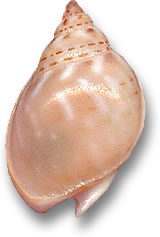Have you ever wondered about the oldest jewelry? Perhaps the oldest jewelry could be an ancient pearl. Maybe it is some 5,000-year-old Egyptian lapis lazuli or some 4,000-year-old Aztec turquoise or gold. Think again! The oldest known jewelry items are two shell beads that were found in Skhul Cave in Israel. The organic beads are around 100,000 years old and about the size of peas. They come from a type of marine mollusk called Nassarius and had been perforated, perhaps by tools made from flint, which led to the conclusion that they were used as beads. It is thought that the beads were not only decorative but also served a symbolic purpose.
A larger quantity of similar beads was also discovered at Blombos Cave in South Africa. The South African beads are around 70,000 years old and differ in that some held traces of red ochre. This suggests that these early beads may have been dyed and could be the very earliest known case of gemstone treatment. Alternatively, the beads could have rubbed against a dyed surface, such as skin that had been coated with red ochre.
Another Nassarius shell bead was also found at Oued Djebbana, Algeria. The bead is thought to be at least 35,000 years old. Since the location of the site where the bead was found was around 160 kilometers from the natural marine habitat of Nassarius, it was concluded that the bead was transported.
These discoveries provide evidence for the evolution of modern humans and suggest that humans originated in Africa. It is thought that humans existed in Africa about 200,000 years ago.
These ancient beads were most likely strung together and worn as a necklace, bracelet or another form of adornment. Evidence of this is in the flattening of surfaces that would have rubbed together and worn down over time. The beads could also have been traded as a sort of early currency.
Nassarius, also known by the less glamorous name, “nassa mud snails” or “dog whelks” can still be found all over the world today. Their Latin genus name comes from the word “nassa”, which means a long, narrow basket used for catching fish. Nassarius feed on fish, but by scavenging rather than trapping them. These attractive mollusks are useful for aquariums in keeping the tanks and sand clean.
The attractive shells of Nassarius have a variety of colors, from white to dark-brown or blackish. The shells can be ridged, smooth, pointed or rounded and some have striped or spotted patterns. Nassariusshells are collected by some and continue to be used in jewelry to this day. Contemporary shell jewelry is diverse and creative, with shells being polished, dyed, painted, coated in resin, drilled, wire-wrapped, mounted in cases or tiny glass bottles with sand, and mixed with precious and semi-precious gemstones. Shells are quite versatile and can be made into pendants, bracelets, earrings, hair decorations and even rings.
The shells from Skhul Cave are currently at the London Natural History Museum in England. The beads from Blombos Cave in South Africa have been featured in a South African stamp collection and the bead from Oued Djebbana in Algeria is held at Musée de l’Homme, in Paris, France.
Source: https://www.gemselect.com/other-info/the-oldest-jewelry-in-the-world.php



